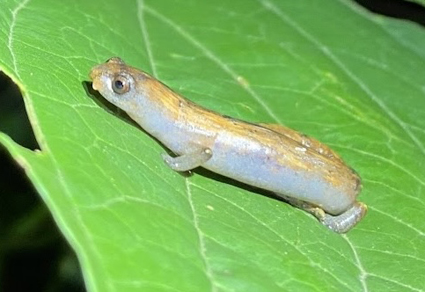Abstract
Bolitoglossa digitigrada Wake, Brame and Thomas, 1982 was described from a few kilometers upstream from the Rio Santa Rosa, Ayacucho Region, Peru, at 1000 m a.s.l. in the Eastern Amazonian Montane Forest. Besides the type specimens, no additional collections or sightings of B. digitigrada had been reported for 43 years, and there is no information about its phylogenetic position inside its group. During a field expedition conducted in October 2022, we found four individuals of B. digitigrada in a corn and banana field near the community of San Jose, approximately 2.7 km from the type locality. Here, we provide information about living specimens, update description of coloration in life, elevation, and evaluate the phylogenetic relationships of B. digitigrada with a molecular phylogeny based on a 16S rRNA sequence.
References
- Chávez, G., García-Ayachi, L.A. & Catenazzi, A. (2023) A new species of frog (Terrarana, Strabomantidae, Phrynopus) from the Peruvian Andean grasslands. Evolutionary Systematics, 7, 105–116. https://doi.org/10.3897/evolsyst.7.96258
- Cusi, J.C., Gagliardi-Urrutia, G., Brcko, I.C., Wake, D.B. & von May, R. (2020) Taxonomic status of the Neotropical salamanders Bolitoglossa altamazonica and Bolitoglossa peruviana (Amphibia: Caudata: Plethodontidae), with the description of a new species from Northern Peru. Zootaxa, 4834 (3), 365–406. https://doi.org/10.11646/zootaxa.4834.3.3
- Duméril, A.M.C., Bibron, G. & Duméril, A.H.A. (1854) Erpétologie Genérale ou Histoire Naturelle Complète des Reptiles. Volume 9. Paris: Librarie Enclyclopedique de Roret.
- Elmer, K.R., Bonett, R.M., Wake, D.B. & Lougheed, S.C. (2013) Early Miocene origin and cryptic diversification of South American salamanders. BMC Evolutionary Biology, 13 (1), 1–16. https://doi.org/10.1186/1471-2148-13-59
- Guindon, S., Dufayard, J.F., Lefort, V., Anisimova, M., Hordijk, W. & Gascuel, O. (2010) New algorithms and methods to estimate maximum-likelihood phylogenies: Assessing the performance of PhyML 3.0. Systematic Biology, 59 (3), 307–321. https://doi.org/10.1093/sysbio/syq010
- Hazzi, N.A., Moreno, J.S., Ortiz-Movliav, C. & Palacio, R.D. (2018) Biogeographic regions and events of isolation and diversification of the endemic biota of the tropical Andes. Proceedings of the National Academy of Sciences, 115(31), 7985–7990. https://doi.org/10.1073/pnas.1803908115
- Herrera-Alva, V., Catenazzi, A. & Aguilar-Puntriano, C. (2023) A new cryptic species of terrestrial breeding frog of the Pristimantis danae Group (Anura, Strabomantidae) from montane forests in Ayacucho, Peru. ZooKeys, 1187, 1–29. https://doi.org/10.3897/zookeys.1187.104536
- Herrera-Alva, V., Díaz, V., Castillo, E., Rodolfo, C. & Catenazzi, A. (2020) A new species of Atelopus (Anura: Bufonidae) from southern Peru. Zootaxa, 4853 (3), 404–420. https://doi.org/10.11646/zootaxa.4853.3.4
- Jaramillo, A.F., De La Riva, I., Guayasamin, J.M., Chaparro, J.C., Gagliardi-Urrutia, G., Gutiérrez, R.C., Brcko, I., Vilà, C. & Castroviejo-Fisher, S. (2020) Vastly underestimated species richness of Amazonian salamanders (Plethodontidae: Bolitoglossa) and implications about plethodontid diversification. Molecular Phylogenetics and Evolution, 149, 106841. https://doi.org/10.1016/j.ympev.2020.106841
- Kalyaanamoorthy, S., Minh, B.Q., Wong, T.K.F., Von Haeseler, A. & Jermiin, L.S. (2017) ModelFinder: Fast model selection for accurate phylogenetic estimates. Nature Methods, 14 (6), 587–589. https://doi.org/10.1038/nmeth.4285
- Katoh, K., Kuma, K.I., Toh, H. & Miyata, T. (2005) MAFFT version 5: Improvement in accuracy of multiple sequence alignment. Nucleic Acids Research, 33 (2), 511–518. https://doi.org/10.1093/NAR/GKI198
- Katoh, K. & Standley, D.M. (2013) MAFFT multiple sequence alignment software version 7: Improvements in performance and usability. Molecular Biology and Evolution, 30 (4), 772–780. https://doi.org/10.1093/molbev/mst010
- Larsson, A. (2014) AliView: A fast and lightweight alignment viewer and editor for large datasets. Bioinformatics, 30 (22), 3276–3278. https://doi.org/10.1093/bioinformatics/btu531
- Linares-Palomino, R., Oliveira-Filho, A.T., & Pennington, R.T. (2011) Neotropical seasonally dry forests: diversity, endemism, and biogeography of woody plants. Seasonally dry tropical forests: ecology and conservation, 3–21. https://doi.org/10.5822/978-1-61091-021-7_1
- Meyer, C.P. (2003) Molecular systematics of cowries (Gastropoda: Cypraeidae) and diversification patterns in the tropics. Biological Journal of the Linnean Society, 79 (3), 401–459. https://doi.org/10.1046/j.1095-8312.2003.00197.x
- Palumbi, S.R., Martin, A., Romano, S., McMillan, W.O., Stice, L. & Grabawski, G. (2002) The simple fool’s guide to PCR, version 2.0. Privately published, compiled by S. Palumbi University of Hawaii, Honolulu.
- Parra-Olea, G., García-París, M. & Wake, D.B. (2004) Molecular diversification of salamanders of the tropical American genus Bolitoglossa (Caudata: Plethodontidae) and its evolutionary and biogeographical implications. Biological Journal of the Linnean Society, 81 (3), 325–346. https://doi.org/10.1111/j.1095-8312.2003.00303.x
- Shimodaira, H. & Hasegawa, M. (1999) Multiple comparisons of log-likelihoods with applications to phylogenetic inference. In Molecular Biology and Evolution, 16 (8), 1114–1116. https://doi.org/10.1093/oxfordjournals.molbev.a026201
- Tamura, K., Stecher, G. & Kumar, S. (2021) MEGA11: Molecular Evolutionary Genetics Analysis Version 11. Molecular Biology and Evolution, 38 (7), 3022–3027. https://doi.org/10.1093/molbev/msab120
- Trifinopoulos, J., Nguyen, L.T., von Haeseler, A. & Minh, B.Q. (2016) W-IQ-TREE: a fast online phylogenetic tool for maximum likelihood analysis. Nucleic Acids Research, 44 (W1), W232–W235. https://doi.org/10.1093/nar/gkw256
- Wake, D.B., Brame Jr., A. & Thomas, R. (1982) A remarkable new species of salamander allied to Bolitoglossa altamazonica (Plethodontidae) from southern Peru. Occasional Papers of the Museum of Natural Science, Louisiana State University, 1 (1), 1. https://doi.org/10.31390/opmns.058


